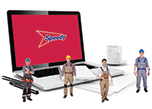
KEEPING YOUR SITE CLEAR OF MUD
Mud doesn’t only cause slip and safety hazards, causing everything to slow down, but vehicle operatives (such as construction sites) are also responsible for keeping the roads around their site clean and safe to use.
Section 148 of the Highways Act 1980 makes it an offence to deposit dirt on a highway that could potentially disturb other users of the highway. Section 149 allows the highway authorities to recover expenses from cleaning the roads from the company causing the issue.
So, as a construction company operating a site, you must keep the roads around you clean. But limiting mud is also essential for the safety of everybody on site. From reducing slip hazards to keeping vehicles gripped to the road, mud prevention is an essential part of all winter plans.
Why is keeping a construction site mud-free so important?
As above, construction sites cannot allow mud to be dispersed onto a public road. This is a hazard which can cause accidents and reduced visibility.
While on-site, excess mud causes everything to move gentler. From plant machinery struggling to grip the ground to unsafe walking pathways, movement will slow down. This isn’t ideal for an industry which can’t afford to stop.
If walkways and roads are unsafe, it also causes slip hazards. You don’t want accidents occurring due to inclement weather, so it is vital to prepare and manage mud.
How to limit mud on a construction site
1. Use tracks on surfaces
It is the surfaces which are driven and walked on regularly which get muddiest. So, putting down tracks and geogrids which can be driven and walked on will reduce the amount of mud produced and the amount which is passed on to feet and tyres.
Something like the Maxi Track Panel will give you maximum support and mud suppression. It is suited to heavy vehicles, so will keep the ground protected and vehicles clean. If you need to protect ground which is already quite boggy and soft underfoot, a TuffTrak Mat will provide temporary roadways for the heaviest of plant machinery.
The Ground Guards FC115 Grass Mat is good for walkways and sections which will be underfoot. It is a good idea to place these all down in time to prepare for the muddy season, but they can also work on existing muddy services.
2. Close off very muddy areas
Any areas which aren’t recoverable without possible excavation and attention should be closed off until the work has been done. Use pedestrian barriers to make it clear they cannot be accessed.
Barriers can also be used to limit the pathways on site. This way, people have to stick to the geogrids which are in place, not taking shortcuts which have not been treated.
3. Have a cleaning station
There is still a risk that mud will be deposited from other areas which are not protected, which may even include areas off-site, so before any vehicles or people leave or enter, have a cleaning station set up which will help get rid of any excess mud.
From a pressure washer or washer bowser to boot brushes and a drying station, cleaning will get rid of any dirt. You need to make sure this area has a good run-off set up, to prevent the water from creating even more mud.
If you have any indoor areas, such as break rooms, keep these clean too. Vacuuming mud or mopping floors regularly is essential. A road sweeper could also help your site remain clean once per week.
4. Keep things covered
Anything which isn’t in constant use, such as building supplies, should be covered. This will lessen mud from spreading. If the mud was to dry, and then get wet again, it would cause excess mud to be produced.
POWER THROUGH WINTER WITH HIRE FROM SPEEDY SERVICES
Speedy Services, the UK's leading tool hire company, have a range of construction site equipment for hire nationwide. Whether you need grass mats to protect your roads and paths or washer bowsers to clear away the inevitable dirt, we have everything you need to keep winter-related site issues at bay.
Speedy has more than 200 service centres across the nation, hire counters in selected B&Qs and nationwide 4-hour delivery, winter tool and site equipment hire has never been easier.
- 2024
- 2023
- December 2023 (13)
- November 2023 (10)
- October 2023 (6)
- September 2023 (10)
- August 2023 (20)
- July 2023 (21)
- June 2023 (17)
- May 2023 (17)
- April 2023 (17)
- March 2023 (14)
- February 2023 (15)
- January 2023 (7)
- 2022
- December 2022 (6)
- November 2022 (12)
- October 2022 (24)
- September 2022 (14)
- August 2022 (12)
- July 2022 (15)
- June 2022 (18)
- May 2022 (14)
- April 2022 (9)
- March 2022 (5)
- February 2022 (5)
- January 2022 (2)
- 2021
- December 2021 (7)
- November 2021 (10)
- October 2021 (1)
- September 2021 (1)
- August 2021 (3)
- July 2021 (3)
- June 2021 (4)
- May 2021 (1)
- April 2021 (1)
- March 2021 (2)
- February 2021 (1)
- January 2021 (1)
- 2020
- 2019
- 2017
- 2016
- 2014
- 2013
- 2012
- 2011


